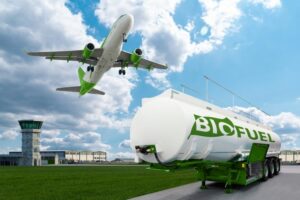GS3 – Environment

Context:
As concerns grow over the aviation sector’s environmental impact, Sustainable Aviation Fuel (SAF) is emerging as a key low-emission alternative.
What is SAF?
- SAF, or aviation biofuel, is a renewable alternative to conventional Aviation Turbine Fuel (ATF) and possesses similar chemical properties.
- It can be produced from:
- Municipal solid waste
- Used oils and fats (e.g., from algae or oilseeds)
- Agricultural residues like sugarcane bagasse, corn stover, and husk
- Wood waste
Why SAF Matters:
- Carbon Reduction: Aviation accounts for 2.5% of global GHG emissions. SAF can potentially reduce these emissions by up to 80% in the future and decarbonise the sector by 60%.
- Compatibility: SAF can be used without altering aircraft engines or refuelling infrastructure.
- Lower Emissions: Produces less particulate matter and helps form cleaner contrails, thereby reducing soot and nitrogen oxide emissions.
- Reduced Import Dependence: Harnessing India’s biofuel potential can lower ATF imports and stabilise fuel prices.
- Affordability: Promotes Atmanirbharta in aviation, possibly making air travel more accessible.
India’s Edge in SAF Development:
- Global Initiatives: India is part of CORSIA and co-founded the Global Biofuel Alliance at G20 (2023) to promote SAF use.
- National Strategy: India has defined its own targets:
- 5% SAF blending by 2030
- 15% by 2040
- Abundant Raw Material: India generates nearly 500 million tonnes of agricultural residue annually—offering a significant feedstock source (MNRE).
Existing Challenges:
- High Cost: SAF is currently twice as expensive as conventional aviation fuel.
- Infrastructure Gaps: There is a lack of production, storage, and distribution infrastructure.
- Feedstock Limitations: Seasonal and regional variations affect consistent feedstock availability.
Way Forward:
- Global Partnerships: Collaborate in initiatives like WEF’s Skies for Tomorrow to secure technology and finance.
- Cost Reduction: Encourage PPP models and tax incentives to make SAF economically viable.
- Research & Innovation: Increase R&D investments in collaboration with academia and industry to accelerate innovation in green aviation fuels.




